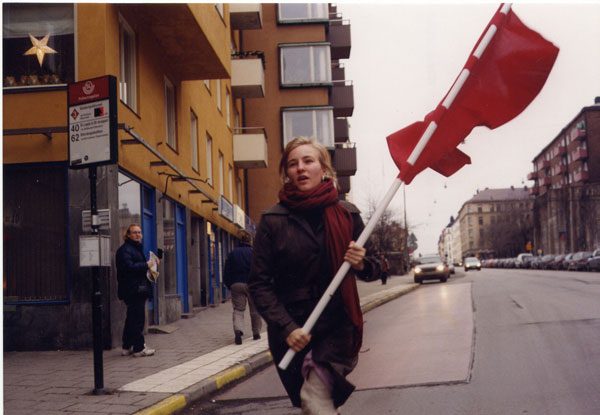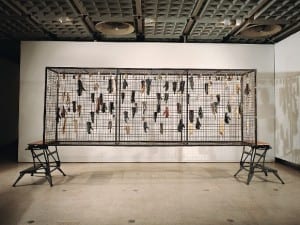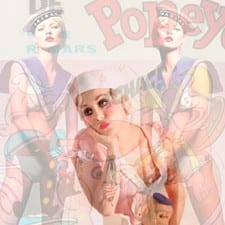Version Control, currently on show at Arnolfini in Bristol, is an extensive group exhibition featuring work by 27 international artists and collectives. Spanning a range of media, what links these works is their relation to the notion of ‘performativity’; the potential of objects and images to represent actions and social processes and the interaction between material ‘things’ and time-based activity. A series of live interventions and events render the exhibition a performative entity in itself, as it is continually re-worked over the course of its duration.
Works are loosely grouped, but not limited to further lines of enquiry; documentation and re-enactment of performances; sculptures as performative objects; appropriation as performance and new information economies after the internet. London-based Argentinian artist Amalia Pica’s work Strangers (2008) could just as easily be a ‘sculpture as performative object’ as it is ‘documentation and re-enactment of performance’. Depending on when you visit, Strangers is either a vibrant string of bunting hung over the gallery entrance or a tableau vivant (living picture) with two actors holding the piece of bunting outstretched in the space. Each time the work is activated, it is done so by two willing participants who have never met each other before, left to negotiate their actions by furtive glances and gestures.
Re-enactment is blurred with appropriation in British artist Tim Etchells’ work Untitled (After Violent Incident) (2013), based on a re-working of American artist Bruce Nauman’s seminal work Violent Incident (1986) which features repetitious stagings of a domestic fight between a couple around a dining table. Etchells deconstructs Nauman’s original work by interpreting it through a written description, which is in turn used to direct a new performance. The installation features a copy of this instructional text hung next to video documentation of the new performance, along with the laid table from the stage set. In an event for a live audience aptly scheduled for Valentine ’s Day, the couple from the video performed once more the hour-long cycle of slapstick violence around the table, completing Etchells’ series of inter-related components which highlight the complex relationship between live action, documentation, prop and script; all equally valid as sites of event.
Through clever choreography, individual works throughout Version Control overlap and interplay. In this first gallery space many of the time-based video, sound and slide works are set to play at intervals. While Etchell’s video plays on a constant loop, 6-minute audio from British artists Andy Holden & David Raymond Conroy’s piece Leaving the Relationship (2013), a series of dramatic readings from David Foster Wallace’s book Brief Interviews with Hideous Men, intermittently demands attention and punctuates the space. Lebanese artist Rabih Mroué’s The Pixelated Revolution (2012), an essayistic video about the use of mobile phones to document acts of violence during the Syrian revolution is also staged at intervals, in this instance allowing it room to breathe.
As well as showcasing a number of recent works by young artists, the exhibition looks at how artists of different generations have handled performativity, proposing an ‘intergenerational topography of forms and themes’. The display of New Order’s music video Bizarre Love Triangle (1986) by late American artist Gretchen Bender traces early appropriation with its rapidly edited images sourced from mass media, while Louise Lawler, another iconic American artist who came to prominence in the 80s, is also included for her work which highlights how artworks perform within their context.
Another notable work is Stolen Pieces (1995 – 1997) by Italian artists Eva & Franco Mattes, which purports to their theft of fragments from a number of artworks by famous artists such as Andy Warhol, Joseph Beuys and Gilbert & George. A vitrine containing said stolen fragments, supposedly including a chip of porcelain from Duchamp’s Fountain, is displayed like forensic evidence alongside covert CCTV footage of the duo lurking suspiciously around museums, prompting further speculation on this secret, mischievous act.
Artistic strategies recur throughout Version Control, such as the spoken or written narration of a moment (Tim Etchells, Ruth Buchanan, Gerry Bibby); appropriation and restaging of existing artworks (Louise Lawler, Seth Price, Felix Gmelin) and the object as evidence, revealing or performing its own narrative (Eva & Franco Mattes, Tobias Madison & Emanuel Rossetti, Morag Keil). Interesting visual and conceptual associations can be made between works and between artists of different generations and backgrounds, but most importantly, Version Control has the unique excitement of an exhibition that won’t be quite the same if visited at another moment and is certainly worthy of time spent with it.
Leela Clarke
Version Control, 2 February until 14 April, Arnolfini, 16 Narrow Quay, Bristol, BS1 4QA. www.arnolfini.org.uk
Credits: Felix Gmelin, Farbtest, Die Rote Fahne II, (Color Test, The Red Flag II), 2002. Still from DV Video. Courtesy Nordenhake, Stockholm / Berlin and Vilma Gold, London. © Felix Gmelin / Gerd Conradt
Version Control is featured in our 10 to see in the current issue of Aesthetica out now. www.aestheticamagazine.com/shop





